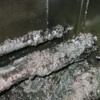quote:
Originally posted by Gilles Van Mol:
Hi,
I have a 6.000l oil reservoir with 18 x 1000W electrical heating elements in the reservoir. The temperature of the elements is 300°C. I think this temperature is much to high and we will change the way of heating the oil (Shell Omala 220 SP2).
Oil analysis: PQ index = 2 (low) and spectrometical analysis (ICP): 1 ppm Fe. Viscosity = 86 cSt!! due to thermical cracking 300°C I think.
Analysis of the hard material around the heating elements (photo): 15.000ppm Fe, PQ index = 1170.
Is there a reason why the ferro magnetic elements like iron agglomerate around these elements?
Kind regards,
Gilles
Hi Gilles,
Shell Omala has a light EP package that will activate @ 300°C,
Why are they having to use Shell Omala rather than a heat transfer fluid like Mobiltherm 605??
If we heat damage heat transfer fluid the system is exceeding the Watts Density of the fluid being heated.
Water has a specific heat value of 100,
Oil has a specific heat value of around 5,
Water conducts heat very efficiently whereas oil does not and although heat is being applied to oil the other side of the reservoir could be cool if no mechanical circulation,
If we force oil to heat faster than the fluid can conduct the heat away the temp of the fluid will increase until the fluid cracks with the heavier ends carbonising with the fluid viscosity reducing and carbon content increasing.
If we increase the area of the heat source the likely hood of “burning” the fluid reduces accordingly,
Your system has pipes with the element inside which does increase the surface area so maybe we have a rogue element with hot spots that is burning the fluid, a check of the elements powering up from cold in an empty reservoir with a thermal camera may indicate any hot spots from faulty elements.
The agglomeration of the ferrous wear debris is most likely due to the magnetic field around the heating elements lightly magnetising the element pipes plus the energy field around the element when operating.
The amount of metallic wear debris in the reservoir appears significantly excessive, we would be inclined to complete a Wear Debris Analysis on the wear debris so the wear mode causing the wear is known and once the wear mode is known the abnormal wear can usually be corrected,
What does the system do??
Thanks
Rob S


